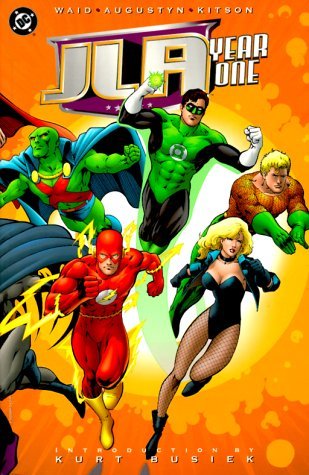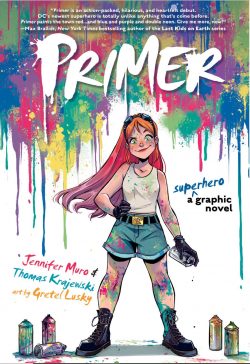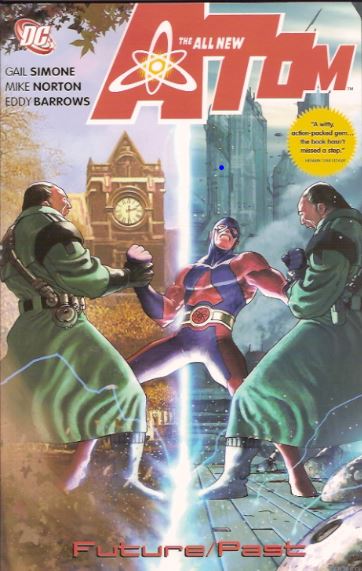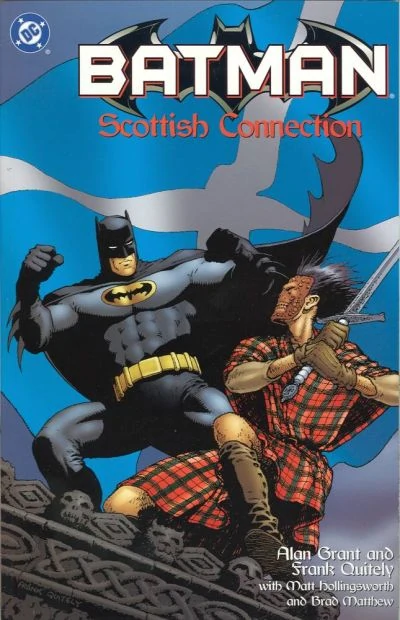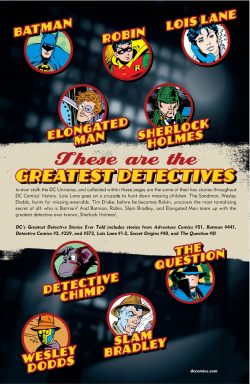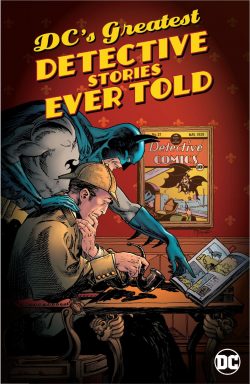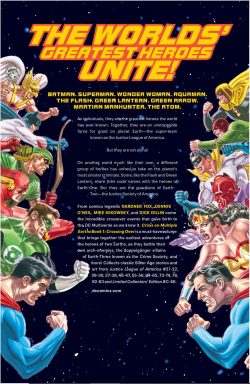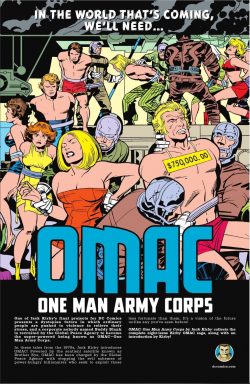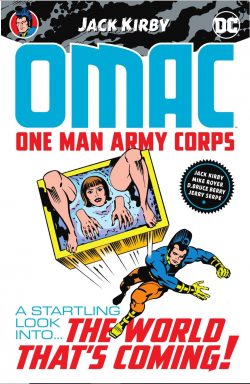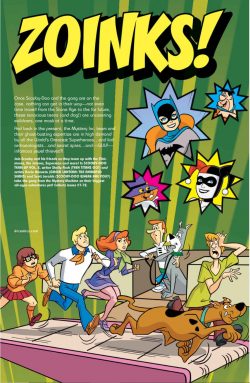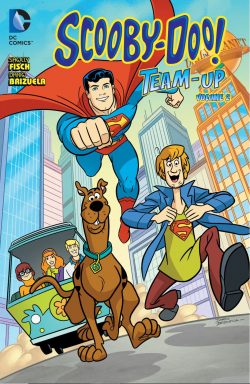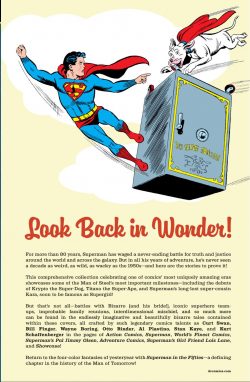
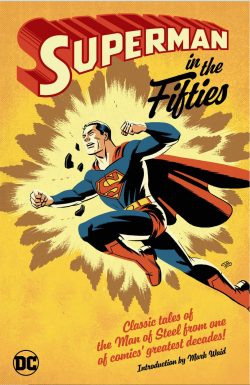
By Robert Bernstein, Otto Binder, Jerry Coleman, Bill Finger, Edmond Hamilton, William Woolfolk, Wayne Boring, Al Plastino, Curt Swan, Win Mortimer, Kurt Schaffenberger, Stan Kaye, Ray Burnley, Sy Barry & various (DDC Comics)
ISBN: 978-1-7795-0758-7 (TPB/Digital edition)
In the early years of this century, DC launched a series of graphic archives intended to define DC’s top heroes through the decades: delivering magnificent past comic book magic from the Forties to the Seventies via a tantalisingly nostalgic blast of other – arguably better, but certainly different – times. The collections carried the cream of the creative crop, divided into subsections, partitioned by cover galleries, and supplemented by short commentaries; a thoroughly enjoyable introductory reading experience. I prayed for more but was frustrated… until now…
First in a trilogy of trade paperbacks – the others being Batman and Wonder Woman (thus far, but hopefully Aquaman, Green Arrow and Martian Manhunter are in contention too, as they have become such big shot screen stars these days) – the experiment is being re-run, including even more inviting wonders from the company’s amazing, family-friendly canon.
Gathered here is an expanded menu of delights adding to that of the 2002 edition, and even rerunning Mark Waid’s original context-stuffed Introduction.
The stories originated in Action Comics #151, 162, 223, 232, 234, 236, 239, 242, 247, 249, 252, 254-255; Adventure Comics #210; Showcase #9; Superman #65, 79-80, 96-97, 118, 125, 127, Superman’s Girl Friend Lois Lane #8; Superman’s Pal Jimmy Olsen #13, 19 and World’s Finest Comics #68, 74, 75 which span the entire decade as the Adventures of Superman TV show propelled the Man of Tomorrow to even greater heights of popularity.
Supported by the first of a series of factual briefings, the collection leads with Part One: Classic Tales, opening on ‘Three Supermen from Krypton!’ Written by William Woolfolk and illustrated by Al Plastino (one of a talented triumvirate who absolutely defined the hero during this decade), it originated in Superman #65, (July/August 1950): a classy clash revealing unknown facts about Superman’s vanished homeworld. It also provided the increasingly untouchable champion with a much needed physical challenge after a capsule containing three comatose Kryptonian lawbreakers crashes on Earth and the inmates suddenly discover they have incredible powers…
Woolfolk and paramount art team Wayne Boring (peak of that triumvirate) & inker Stan Kaye probed outer space to provide another daunting threat in ‘The Menace from the Stars!’ (World’s Finest Comics #68, January/February 1954). However, all was not as it seemed in this quirky mystery, as a brush with a Green Kryptonite-infused asteroid gave the Man of Steel amnesia. Happily, before he could inadvertently expose his secret identity, another sudden impact set things aright…
Bill Finger, Boring & Kaye crafted ‘The Girl Who Didn’t Believe in Superman!’: a fanciful yet evocative human interest tale typical of the era and sorely missed in modern, adrenaline-drenched times. Cover-dated March 1955, the tearjerker from Superman #96 shared the tribulations of a blind child losing hope and is followed by a previously unseen entry.
‘It!’ debuted in Action Comics #162 (November 1951 by Finger, Boring & Kaye): an early alien-menace-with-a-moral yarn depicting a destructive rainbow-hued enigma terrorising Metropolis until the Man of Steel deduces the thing’s incredible secret.
Superman #97 (May 1955) carried Jerry Coleman, Boring & Kaye’s canonical landmark ‘Superboy’s Last Day in Smallville!’, revealing the previously unseen rite of passage by way of exposing a crook’s decades-delayed masterplan, after which Action Comics #239 exposes ‘Superman’s New Face’ (April 1958) – courtesy of famed pulp writer Edmond Hamilton, Boring & Kaye. When an atomic lab accident deforms Superman to the point that he must wear a full-face lead mask, there is – of course – method in his seeming madness…
The first section closes with a tale from one of the many spin-off titles of the period – and one that gives many 21st century readers a few uncontrollable qualms of conscience. Superman’s Girl Friend Lois Lane was one of precious few comics with a female lead, but her character ranged erratically from man-hungry, unscrupulous schemer through ditzy simpleton to indomitable and brilliant heroine – often all in the same issue.
Most stories were played for laughs in a patriarchal, parochial manner; a “gosh, aren’t women funny?†tone that appals me today – but not as much as the fact that I still love them to bits. It helps that they’re all so beautifully illustrated by sublimely whimsical Kurt Schaffenberger. ‘The Ugly Superman!’ comes from #8 (April 1959), revealing how a costumed wrestler falls for Lois, giving the Caped Kryptonian another chance for some pretty unpleasant Super-teasing. It was written by the veteran Robert Bernstein, who – unlike me – can cite the tenor of the times as his excuse.
As the franchise expanded, so did the character roster and internal history. Part Two: The Superman Family is dedicated to our hero’s ever-extending supporting cast, leading with ‘Superman’s Big Brother!’ (Superman #80, January/February 1953). Scripted by Hamilton and limned by Plastino, it sees a wandering super-powered alien mistaken for a sibling, before an incredible truth comes out. It’s followed here by previously unreprinted tale ‘The First Superman of Krypton’ (Hamilton, Boring & Kaye, Action Comics #223, December 1956) with Superman finding video records from his birthworld and learning how – and why – his father Jor-El briefly enjoyed powers under a red sun…
Next comes the introduction of a genuine new family member. After the Man of Tomorrow made his mark as Earth’s premier champion, his originators took a long look and reasoned that a different perspective could provide a fresh look. What would it be like for a fun-loving lad who could do literally anything?
Answers came as Jerry Siegel & Joe Shuster – following years agitating their publisher – unleashed Superboy: inventing and/or fleshing out doomed Krypton, Kal-El‘s early years, foster parents and a childhood full of fun and incident. The experiment was a huge hit and the lad swiftly bounced into the lead spot of Adventure Comics and – in 1949 – his own title: living a life forever set 20 years behind his adult counterpart.
Encountering crooks, monsters, aliens, other super kids, school woes and the suspicions of girl-next-door Lana Lang, the Boy of Steel enjoyed an eventful, wonderful life which only got better in Adventure Comics #210 (March 1955), as Otto Binder, Curt Swan & Sy Barry introduced a wayward, mischievous and dangerously playful canine companion who had survived Krypton’s doom due to a freak accident in ‘The Super-Dog from Krypton!’.
Krypto had been baby Kal-El’s pet on Krypton before being used by desperate Jor-El as a test animal for the space rocket he was building. The dog’s miraculous arrival on Earth more than a decade later heralded a wave of survivors from the dead world over the latter part of the decade: all making Superboy less lonely and unique. Every kid needs a dog…
Fresh additions follow, beginning with ‘The Story of Superman, Junior’ (Action Comics #232, September 1959, by Coleman, Boring & Kaye) which sees the Man of Tomorrow adopt a super-powered lad whose space capsule crashes outside the city. However, Johnny Kirk is human, vanished from Earth years previously and his strangely familiar origin and eager inexperience poses an existential threat after the hero adopts him…
Cover-dated December 1958, Action Comics #247 details how an insidious criminal scheme to expose the hero’s secret identity prompts an extreme face-saving solution in Binder & Plastino’s ‘Superman’s Lost Parents!’ before we reach the landmark which, more than any other, moved Superman from his timeless Golden Age holdover status to become a vibrant part of the DC Silver Age revival. It came in in Action Comics #252 (May 1959) as ‘The Supergirl from Krypton!’ introduced cousin Kara Zor-El, born on a city-sized fragment of Krypton, which was somehow hurled intact into space when the planet exploded.
There had been a few intriguing test-runs before the future star of the ever-expanding Superman universe finally took off, but now the stage was set.
Eventually, Argo City turned to Kryptonite like the rest of the detonated world’s debris, and her dying parents – observing Earth through their scopes – sent their daughter to safety as they perished. Landing on Earth, she met Kal-El, who created her cover-identity of Linda Lee: hiding her in an orphanage in small town Midvale so she could learn about her new world and master her new powers in secrecy and safety. This time the concept struck home and the teenaged refugee began her lengthy career as a solo-star from the very next issue.
This section ends with another popular animal guest-star who was also one of the most memorable recurring super-foes of the period. ‘Titano the Super-Ape!’ debuted in Superman #127 (February 1959): a chimpanzee mutated into a Kryptonite-empowered King Kong analogue after being launched into space by rocket scientists. The chimp’s devotion to Lois and big hatred for the Man of Steel were unchanged in the aftermath, and as a skyscraper-sized giant ape with kryptonite vision, he became too dangerous to live. Thankfully, the Action Ace found another way in this beloved masterpiece by Binder, Boring & Kaye combining action, pathos and drama to superb effect.
Part Three: The Villains highlights our hero’s greatest enemies, leading with a team-up of The Prankster, Lex Luthor and extra-dimensional sprite Mr. Mxyztplk in a tale more mirthful mystery than moment of menace and mayhem. Devised by Hamilton, Boring & Kaye from Action Comics #151, December, 1950) ‘Superman’s Super-Magic Show!’ is followed by ‘The Creature of 1,000 Disguises!’ (Action Comics #234, November 1957) by the same team, with the hero plagued by a shapeshifting alien whose idea of fun is juvenile, frustrating and potentially catastrophic.
Superman #118 (January 1958) sees an uncredited writer & Plastino detail ‘The Death of Superman!’ Â as a fake Man of Steel tricks Lois in an attempt to secure damaging evidence after which Binder, Boring & Kaye reveal ‘Superman’s New Uniform!’ (Action Comics #236, January 1958) as a deadly plot by Luthor to destroy his arch enemy.
Binder & Plastino introduced both the greatest new villain and most expansive character concept the series had yet seen in Action Comics #242, (July 1958) as ‘The Super-Duel in Space’ saw evil alien scientist Brainiac attempt to add Metropolis to his menagerie of miniaturised cities in bottles.
As well as a titanic tussle in its own right, this tale completely changed the mythology of the Man of Steel: introducing Kandor, a city full of Kryptonians who had escaped the planet’s destruction when Brainiac captured them. Although Superman rescued his fellow survivors, the new villain escaped to strike again and again. It would be years before the hero restored the Kandorians to their original size.
Action Comics #249, (February 1959) sees Luthor deliberately irradiate himself with Green K to avoid capture in Binder & Plastino’s ‘The Kryptonite Man!’, but his evil genius proves no match for our hero’s sharp wits, used with equal aplomb in ‘The Battle with Bizarro!’ (Action #254, July 1959) by the same creative team. This story actually re-introduced the imperfect duplicate, who had initially appeared in a well-received story in Superboy #68, from 1958. Even way back then, sales trumped death…
The Frankensteinian doppelganger was resurrected thanks to Luthor’s malfunctioning duplicator ray and Bizarro’s well-intentioned search for a place in the world caused chaos, exacerbated when the lonely monster used the device to make more of his kind. The saga was continued over two issues – an almost unheard of luxury back then – concluding with outrageous empathy in ‘The Bride of Bizarro!’ (#255, August 1959).
Final section Part Four: Superman’s Pals stems largely from that epochal television show, which made most of the supporting cast into household names., but begins with an early exploit of the “World’s Finest Team†from World’s Finest Comics #74, January/February 1955. The great friends’ solidarity is upset after a shapeshifting alien orchestrates a manic rivalry but ‘The Contest of Heroes’ (Finger, Swan & Kaye) is not what it seems…
Superman #79 (November/December 1952) has Hamilton & Plastino depict how a corrupt publisher seeks ‘The End of the Planet!’ but is outfoxed by the dedication of the reporters he made jobless whilst ‘Superman and Robin!’ is a classic bait-and-switch teaser from WFC #75 (March/April 1955), wherein a disabled Batman can only fret and fume as his erstwhile assistant seemingly dumps him for a better man. I’m sure Finger, Swan & Kaye knew that no-one would believe that they had really broken-up the Batman/Boy Wonder team, but the reason for the ploy is a killer….
The Adventures of Superman television show launched in the autumn of 1952, adopting its name from the long-running radio serial that preceded it. It was a monolithic hit of the still young medium and National Periodicals began tentatively expanding their increasingly valuable franchise with new characters and titles. First up were the gloriously charming, light-hearted escapades of that rash, capable but naïve photographer and “cub reporter†from the Daily Planet. The solo-career of the first spin-off star from the Caped Kryptonian’s ever-expanding entourage began with Superman’s Pal Jimmy Olsen #1, which launched in 1954 with a September-October cover date. Here, ‘The Stolen Superman Signal’ (#13, June 1956, by Binder, Swan & Ray Burnley) perfectly displays the lad’s pluck and aura of light-hearted whimsy that distinguished the early stories when criminals target the cub reporter’s secret weapon: a wristwatch emitting a hypersonic sound only the Action Ace an hear…
The Planet’s top female reporter also got her own comic book thanks to TV exposure, but it took another three years for the cautious Editors to tentatively push that boat out again. In 1957, just as the Silver Age was getting going, try-out title Showcase – which had launched The Flash in #4 & 8) and Challengers of the Unknown (#6 & 7) – followed up with a brace of issues entitled Superman’s Girl Friend Lois Lane. Soon after they awarded the “plucky News-hen†a series of her own. Technically it was her second, following a brief mid-1940s string of solo tales in Superman.
From Showcase #9 (June/July 1957) ‘The Girl in Superman’s Past!’ is by Coleman & Plastino, introducing an adult Lana Lang as a rival for superman’s affections and beginning decades of sparring that led to many a comic-book catfight…
Superman’s Pal Jimmy Olsen #19 (March 1957, by Binder, Swan & Burnley) contributed comedy classic ‘Superman’s Kid Brother’ as major head trauma convinces the cub reporter that he is also superpowered and cruel circumstance keeps that misapprehension alive long past the point where his life is endangered…
The last tale in this section – and the volume – is ‘Superman’s New Power!’ by Coleman, Boring & Kaye from Superman #125 (November 1958). Here an uncanny accident grants the Man of Steel new and incomprehensible abilities with catastrophic consequences…
Also including an extensive cover gallery by Plastino, Boring, Swan, Win Mortimer, Kaye & Burnley, and extensive creator Biographies, this is a wonderful slice of comics history, refreshing, comforting and compelling. Any fan or newcomer will delight in this primer into the ultimate icon of Truth Justice and The American Way.
© 1950, 1951, 1952, 1953, 1954, 1955, 1956, 1957, 1958, 1959, 2020 DC Comics. All Rights Reserved.
